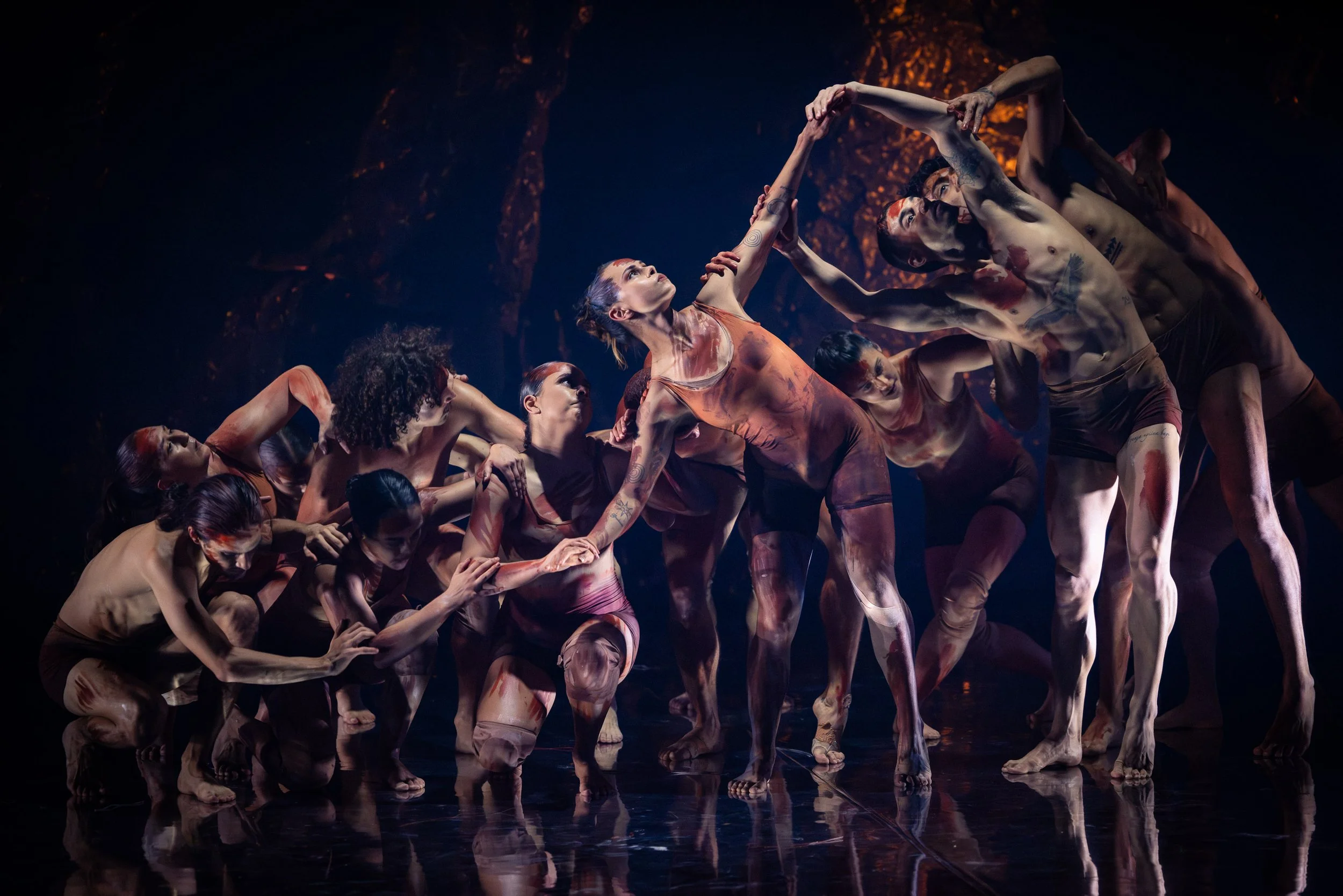Horizon | Bangarra Dance Theatre
All images: Daniel Boud
I must confess to being a long-standing admirer and supporter of Bangarra Dance Theatre, and I’m one of many to describe Bangarra as a ‘national treasure.’ Bangarra is known for the highest standards of contemporary dance in works that draw on the stories, experiences, knowledge and history of Indigenous Australia. I describe their works as amazing, visually rich events that showcase powerful stories, each communicated through theatrical dance and illustrated with powerful soundscapes (and great lighting, costumes and set design).
For me, Bangarra is so much more than a ‘contemporary dance’ label might suggest. If you love at least one of circus, cabaret, theatre, indigenous story and knowledge, music, fabulous costumes, and great art… I am guessing you will also find much to enjoy in Bangarra’s work.
In their program introduction, Bangarra co-CEOs (Artistic Director Frances Rings, and Executive Director Louise Ingram) refer to Horizon—a commission of work by ’three new choreographic voices’ that are each new to Bangarra audiences—as representing ‘a fresh and dynamic new chapter in our artistic and cultural songline,’ noting that ‘through story we build a global First Nations creative network.’
All images: Daniel Boud
Just as the horizon is described as the meeting place between sea, sky, and land, so Horizon is a two-act showcase of the work of three First Nations choreographers. Kulka is an inspiring 20-minute opening piece, which is described as ‘paying homage to Sani Townson’s grandfather and Torres Strait heritage.’ The longer second act, The Light Inside, is a thrilling piece, with two distinct halves. The Light Inside, Salt Water is what Deborah Brown describes as ‘an homage to my mother and the connection to the sea, sky and land of her people.’ Finally, the closing The Light Inside, Fresh Water work by Moss Te Ururangi Patterson, is described by Patterson as being ‘about remembering to never let the light go out.’
Kulka is a great choice for this two-act show, with four distinct sections that make use of exceptional staging and projections. The opening Danakayg (Life) section was really special, creating a clear sense of the story of new life coming from the stars—enhanced not only by the work of the incredible dancers, but also with the costume choices. The ‘new life’ dressed in a glorious blue ‘dress’ and the other dancers wearing fabulous black spangled body suits, creating a sense of puppetry and manipulation of the star from the ‘sky’ (Clair Parker, Kulka costume design).
During the Kulka performance, I was equally fascinated by watching Bangarra’s dancers performance on the stage and seeing their work reflected onto the angled surface overhead. This was particularly for the third section, where David Bergman’s AV Design ensured that we not only saw the crocodile god as performed by the dancers, but we also watched a projected crocodile animation (and then body paint) as a ‘surface’ on which the dancers appeared to move. Amy Flannery’s music was such a fantastic part of this piece, with the rising and ominous crocodile god drumming, and the concluding ‘Blood is thicker than water.’
All images: Daniel Boud
The second act The Light Inside is a piece in the best traditions of Bangarra, with so many favourite moments. Deborah Brown is a ‘Bangarra alum,’ and the fluid and clever Salt Water choreography included echoes from previous Bangarra shows, but in new and incredibly memorable ways. My four favourite elements of this piece were Daniel Mateo’s mesmerising opening Cylinder solo, the striking and beautiful Sails section (such a serene contrast to the energy and power of The Divers), Lillian Banks’ scintillating Blue Star, and the Rejuvenation section that featured Daniel Mateo and Janaya Lamb’s poignant Seed, and the full ensemble Leaves. The dancers were amazing, the soundscape so well chosen (composers Steve Francis and Brendon Boney), and Jennifer Irwin’s costume design never disappoints. Irwin’s costume designs are often better described as works of art.
Patterson’s The Light Inside, Wai Māori /Fresh Water is a powerful, pulsing and often fierce piece with which to close the show. Most of the sections were danced by the full ensemble in an exciting, moving, and occasionally confronting piece that included a powerful haka, and also clever interweaving of two traditional stories about ‘sacred hair.’ I have never seen such gentle and creative moves, with the interplay of braided and long hair, and I loved the clever ways in which headdresses and shapes were created by the dancers. Quite how any of the performers could move, let alone breathe, after this powerful second piece kept me musing during most of our post-show discussion.
If you are new to Bangarra’s work, then Horizon is for you. If you are looking for a memorable creative and cultural experience, then Horizon is for you. If you want to admire exceptional cutting-edge contemporary dance, with great music, lighting and costumes … Horizon is also for you.
I see that the website has a ‘cheat sheet,’ and access to a copy of the excellent digital program. So, if you’d like to learn more, I’d suggest you check out those resources. But, as there is low availability across the rest of this short run, I suggest you first buy tickets while you can (and then review the information at your leisure before you see the show). Bangarra’s Horizon is an unmissable experience.
Bangarra’s ‘Horizon’ plays at QPAC, South Brisbane from 8-17 August 2024, at QPAC, South Brisbane as part of QPAC’s Clancestry program (Clancestry closes 9 August). Please note that the production contains recordings of the voices of Tangata whenua, Aboriginal and Torres Strait Islander people who have passed. 110 minutes, including a 20-minute interval.
All images: Daniel Boud



